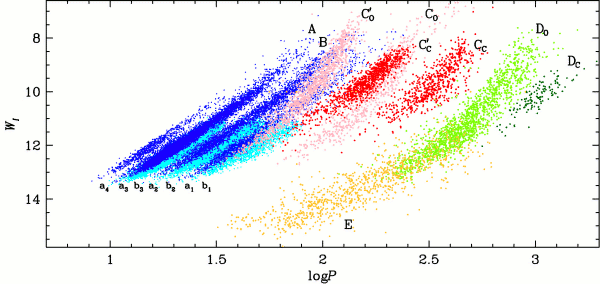Period-Luminosity Relations of Variable Red Giant Stars
Period-luminosity (PL) relations of variable red giants in the Large (LMC) and Small Magellanic Clouds (SMC) are presented. The PL diagrams are plotted in three planes: logP-KS, logP-WJK, and logP-WI, where WJK and WI are reddening free Wesenheit indices. Fourteen PL sequences are distinguishable, and some of them consist of three closely spaced ridges. Each of the sequences is fitted with a linear or quadratic function. The similarities and differences between the PL relations in both galaxies are discussed for four types of red giant variability: OGLE Small Amplitude Red Giants (OSARGs), Miras and Semiregular Variables (SRVs), Long Secondary Periods (LSPs) and ellipsoidal variables.

We propose a new method of separating OSARGs from non-variable stars and SRVs. The method employs the position in the reddening-free PL diagrams and the characteristic period ratios of these multiperiodic variables. The PL relations for the LMC OSARG are compared with the calculated relations for RGB models along isochrones of relevant ages and metallicities. We also compare measured periods and amplitudes of the OSARGs with predictions based on the relations valid for less luminous solar-like pulsators.

Miras and SRVs seem to follow PL relation of the same slopes in the
LMC and SMC, while for LSP and ellipsoidal variables slopes in both
galaxies are different. The PL sequences defined by LSP variables
and binary systems overlap in the whole range of analyzed wavebands. We put
forward new arguments for the binary star scenario as an explanation of the
LSP variability and elaborate on it further. The measured pulsation to
orbital period ratio implies nearly constant ratio of the star radius to
orbital distance, R/A=0.4, as we find. Combined effect of tidal
friction and mass loss enhanced by the low-mass companion may explain why
such a value is preferred.
The paper is available via
astro-ph/07102780
PLEASE cite the following paper when using the data or referring to these
OGLE results:
Soszynski et al., 2007,
Acta Astron., 57, 201.
 back
back